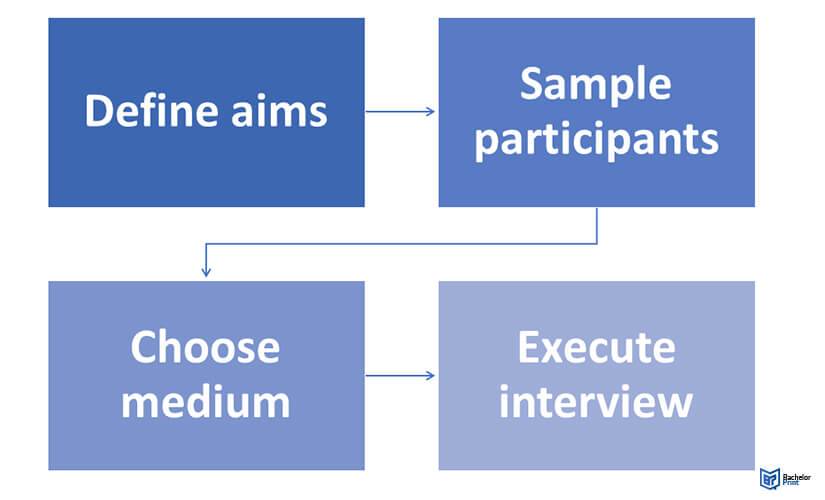
Hiring managers use different types of interviews to get qualified personnel. While the process can become time-consuming and nerve-racking, an unstructured format could make it fun and easier for the interviewers and interviewees. This article discusses unstructured interviews, frequently asked questions (FAQs) about such interviews, pros and cons to be aware of, and how to conduct such an interview successfully.
Definition: Unstructured interview
An unstructured interview, also known as a non-directive interview, is an informal meeting that doesn’t use a particular pattern and its questions aren’t pre-meditated. These interviews are often qualitative; hence, they’re helpful in humanities and social sciences research aiming at personal experiences.
Unstructured interviews serve as an excellent exploratory research tool. Other types of interviews include semi-structured interview, structured interview, and focus group interviews.
Assessing when to use an unstructured interview
Sometimes, conducting an unstructured interview can be pretty challenging, or it might not be ideal. Therefore, use this interview method when:
- You have enough interviewing experience and a strong background on your research topic.
- Your research topic is exploratory and may need new and shifting opinions even though you already have a hypothesis.
- You need descriptive data and are willing to ask more questions that will contextualize and deepen your prior hypotheses and ideas.
- You need your participants to feel relaxed and comfortable to reveal more profound thoughts, emotions, and experiences.
Since the questions are not pre-set, data collection and analysis become more complex in an unstructured interview. Therefore, always remain organized or develop a system that keeps track of your candidates’ responses.
Unstructured interview — Citation/translation explanations
Unstructured interview questions may confuse the reader, so use notes to explain the information or translations.
Unstructured interview, semi-structured, and structured interview
The following table shows the differences between the three types of interviews:
| Structured interviews | Semi-structured interviews | Unstructured interviews | |
| Fixed Questions | Yes | Yes | No |
| Fixed Order of Questions | Yes | No | No |
| Fixed Number of Questions | Yes | No | No |
| The Option to Ask Additional Questions | No | Yes | Yes |
The pros and cons of an unstructured interview
There are many advantages and disadvantages of using an unstructured interview method, and some of the pros include:
- Flexibility: They’re flexible and created much like a normal conversation, fostering a friendly environment where new ideas and topics flow.
- Comfortable Structure: Their structure helps candidates feel more at ease, disrupting the power differential inherent in the interviewer-interviewee dynamic.
- Reduced Socially Desirable Bias: This makes them ideal for traumatic or sensitive subjects.
- More Detailed: They introduce more nuance and detail, prompting even more ideas you hadn’t considered initially.
Some of the cons include:
- Challenging to Monitor Questions: Since more questions may arise, it may derail the aim of your research and decrease your internal validity.
- Time-consuming: Unstructured questions can consume much time for the analysis and interview. You may also take more time transcribing the information.
- Prone to Bias: These interviews may sometimes tempt you to ask open-ended or leading questions, creating biases.
- Unreliability: The lack of room to compare answers from the different candidates minimizes generalizability and reliability.
Constructing questions for an unstructured interview
Depending on the conversation’s flow and your participants’ cues, you may find it challenging to ask unstructured questions that bring the desired answers for your research.
Here are some tips that can help:
- Research more on your topic. Conduct extensive research and ensure you’re comfortable with creating relevant questions spontaneously.
- Write a guide. If you get stuck or the interview takes another turn, you can always refer to your notes for guidance.
- Avoid closed-ended questions. Try asking questions that elicit lengthy answers and avoid close-ended questions whose answers are “no” or “yes.”
- Use “why” questions often. These questions help your candidates avoid and ease feelings of anxiety or defensiveness.
- Use icebreakers. Start the interview in a more comfortable and relaxed tone before going for the more sensitive topics.
4-step guide to conducting an unstructured interview
Proceed with the following steps after determining that an Unstructured interview is your best fit:
1. Aims and foundations
Know the aim of your research and begin by asking: “What do I plan to learn from the research?” or “why is an unstructured interview ideal?”
While you can’t set questions beforehand, plan your unstructured interview. Once you’re sure about your research topic, brainstorm the categories of questions you’ll likely ask.
2. Sampling participant’s
Use voluntary, stratified, or convenience sampling in the second step. However, be careful of sampling bias where you’re more likely to choose a specific population than others.
3. Choosing the medium
Understand the advantages and disadvantages of using the different data collection mediums, as shown in the table below:
| Medium | Pros | Cons |
| Video conferencing | The respondent is comfortable in their home | May feel stilted or awkward |
| In-person | • Decreased interruptions • Controlled environment • Easy to read body language |
May cause interviewer effect or nervousness |
| Over the phone | Elicits more honest responses | Environmental conditions may distort answers |
Also, ensure that your candidates give their consent, preferably a written one or a signature on the confidentiality agreement.
4. Executing the interview
Pay attention to conditions that may impact your interviews, like noise, body language, temperature, and setting. Keep your questions unbiased and natural, and ask open-ended questions to keep the conversation flowing.

Analyzing an unstructured interview
Assign your participants a pseudonym or number in the analysis stage before transcribing the recorded interviews. Conduct thematic or content analysis to create categories and find patterns within your responses and hypotheses.
Transcribing unstructured interviews
Transcribing unstructured questions can be lengthy because of excessive details. First, know if you’re using:
- Intelligent verbatim transcription that includes filler words like “mmm,” hesitations, and laughter in your research, or,
- The intelligent verbatim transcription that excludes these fillers and saves time.
Transcribing helps cleanse your data before adding it to the appendix of your paper.
Coding unstructured interviews
Coding is the process of separating patterns, words, or repeated responses into categories for later analysis. Thematic analysis is ideal for unstructured questions to identify common ideas, topics, or patterns; therefore:
- After you’re satisfied with your responses, separate them into different labels or codes.
- Proceed by categorizing similar labels into broader themes.
- Double-check themes to ensure they appropriately represent your data.
The analysis
After coding, choose to either use a deductive or inductive analysis approach, as follows:
- An inductive approach is open-minded and allows your data to determine your themes
- A deductive approach investigates whether your data confirms the preconceived ideas or themes.
Thematic analysis may be subjective, leading to unreliability of your results, so always remain objective when analyzing unstructured questions.
Illustrating results of an unstructured interview
After data analysis, combine your results into a research paper that covers the following sections:
- Methodology: It describes the data collection process and explains how you conceptualize and justify your analysis.
- Discussion: It adds suggestions for future studies since unstructured questions are exploratory. The section describes your coded labels and showcases your arguments.
- Conclusion: It finishes with your major takeaways and avenues for further research.
FAQs
They’re flexible, interactive, and valid, making understanding and analyzing the participants easier.
Unstructured interviews make candidates more relaxed, so they’ll willingly disclose relevant information they would otherwise forget.
It’s a tendency where the participant alters their behavior so that you may view them favorably.
